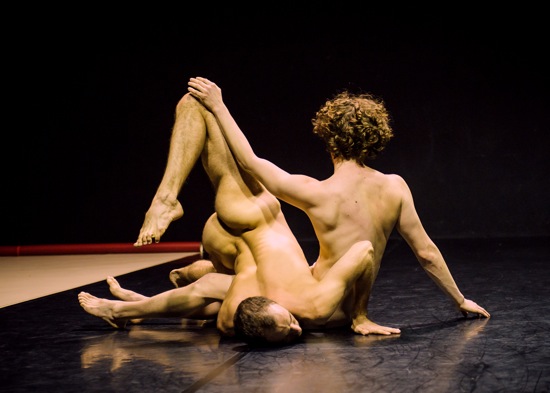
Burr Johnson and Benjamin Asriel (seated) in John Jasperse's Fort Blossom revisited. Photo: Ian Douglas
Maybe this is something you haven’t scrutinized before; maybe it’s a familiar sight. But I imagine you haven’t noticed an asshole in quite this way. To begin John Jasperse’s Fort Blossom revisited, Benjamin Asriel begins an arduous trek on his belly across the floor of New York Live Arts; arms at his sides, he undulates along by a smooth process of humping and arching. Depending on where you’re sitting, you may notice that the action makes the crack between his buttocks widen and narrow rhythmically). Among the several thoughts this image can evoke is this: it’s like watching a bivalve at work underwater.
Fort Blossom isn’t the first piece in which Jasperse has juxtaposed hot material to cool form with an aim to discomfit us. In a memorable sequence in his earlier Excessories, two men and two women, standing shoulder to shoulder, blank-faced, opened their jackets or flies, took out their genitals or breasts, and made them dance in fastidious synchrony. Fort Blossom (expanded from its 2000 version) confronts us more obliquely with questions about the way we look at dancers in performance, in particular, the erotic reaction we may indulge in or suppress. He also invites us to compare dressed bodies with unclothed ones, male with females, controlled actions with spontaneous ones, and individuals with pairs with a group.
As Asriel worms his way across the two-toned floor from its white half onto the black part, designer Stan Pressner initially bathes his pale body in almost mortuary light—a moving anatomy lesson. When he arrives at his destination and halts, Burr Johnson, also naked, rises from the large, square, clear plastic pillow he’s been draped over, advances on Asriel, lays the pillow over him, and lies on top of both. Then he pulls the plug on the pillow and, by grinding his pelvis, causes it to deflate. You could think of the pillow as a mega-condom, but also as a disappearing barrier. Or you could define the whole stack as a surreal machine and focus on the two women who have been taming their own pillows on the white area of the stage.
Jasperse has overturned the prevalent vision of female nudity in painting. Think of Manet’s Le Déjeuner sur l’Herbe, with its two smartly clad gentlemen picknickers and a naked woman who looks out at us from the canvas, with a half-clad woman bathing in a stream. Lindsay Clark and Erika Hand wear short, long-sleeved, loose-fitting, rust-red dresses in a stretch jersey. As they settle down on orange-tinted ottomans, the plastic emits unruly squeaks and mild groans. To dance, the women snap the pillows on like backpacks.
When I first saw the re-vamped Fort Blossom at Bryn Mawr College, I was in Philadelphia to lead sessions of the ThinkingDance Project. Afterward the participants reviewed and discussed the performance. The word “robotic” came up frequently in descriptions of the women, also “stewardesses.” I think the latter image has something to do with the costumes, but also the straight-armed or angled gestures that Clark and Hand perform in unison could call to mind those airplane pantomimes that point out exits and the intricacies of seatbelts. As the women, perfectly synchronized, angle their bodies and fall back and swing their arms, they sometimes invest their gazes with traces of emotion (fear perhaps) that bely the preciseness that makes us think “robot.” Or perhaps: “retro-futuristic.”
One of the selections from recordings by Ryogi Ikeda kicks in with a loud buzzing as the women unsnap their cushions and lie side by side beneath them—a contrast to the men’s more intimate rest-period after all the air has gone out of their pillow sandwich. But the buzz disappears and the lights change when the mens’s duet begins. Here your gaze falters, keeps switching gears. The men are art objects, like the beautiful ephebes portrayed in Greek statuary, and they move slowly and unemotionally through a smooth sequence of shifting tableaux.
Jasperse plumbs the subtle shading that some say distinguishes nudity from nakedness. Asriel and Johnson don’t move in ways that would conceal their genitals or anuses (buttocks are indeed prominent—perching on feet, grazing shoulders), and the choreography gives us time to feel the sensuousness of, say, Asriel’s butt sliding down the slanted arm that Johnson, seated on the floor, braces for him. Gravely and considerately, the two work at interlocking their bodies and limbs in unusual and intricate ways that are never explicitly sexual. Sometime one levers the other off the ground. The sequence is beautifully designed—gradually increasing its pace and expanding in space; occasionally Jasperse breaks the tension by having one of the partners drop out of a maneuver with an audible thump as he moves to a new position. Once, near the end of the duet, the two look each other in the face for the first time. It may be the most provocative moment of all.
I can’t decipher the atmosphere in the theater. Are some of the gazes prurient? Are some of the viewers turned on? Are many simply rapt, hypnotized? In any case, Jasperse changes our perspective. Wielding four pillows, the performers turn what seems like an accidental collision into a game of racing around smacking into one another. The horseplay is surely improvised. They attempt individual feats with the props, many of which fail; they laugh; we laugh. The music turns raucous (do I hear a samba?). Some of the players are naked, some are clothed. So what?
Jasperse isn’t through with comparisons. The dancers pair up, again by gender, in double duets that explore variants of choreography we’ve already seen. It’s no surprise that the dresses not only shield the women from each other, they blur and minimize the intimacy of the movements (it makes me wonder what a traditional ballet pas de deux would convey were both partners naked). Jasperse rings all kinds of changes on his theme. The men dance with the women (now the duets seem slightly more manipulative). You see couples in unison, in canon, and in two different but related dances, separated in space. Your eye travels around, parsing similarities, parsing differences. The selection of Ikeda’s music is almost hymn-like.
In the final sequence, the four work in a chain—sometimes side by side, sometimes pressed together into a caterpillar, sometimes linked. Equality and individuality are the new norms. One may break away and rejoin; another may start something the others pick up. Always their behavior is serene, controlled, amicable, workmanlike. This is who they are; this is what they do.
At the end, the brave, very gifted performers simply step out of the dance and bow. No lights out so the men can reappear with their private parts covered. That practice has always struck me as awkward; the performer distances himself or herself from the previous nakedness, which serves to confirm the shocking aspect of public nudity. Asriel and Johnson were/are naked. I like it that Jasperse stirs things up—risking our discomfort (or worse). With exquisite precision, he challenges us to consider how we view not just these dancers, but all dancing bodies.

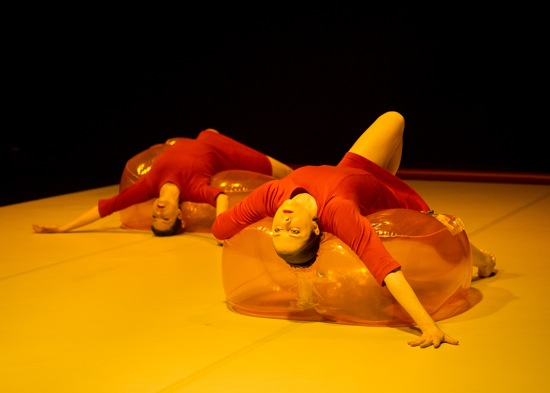
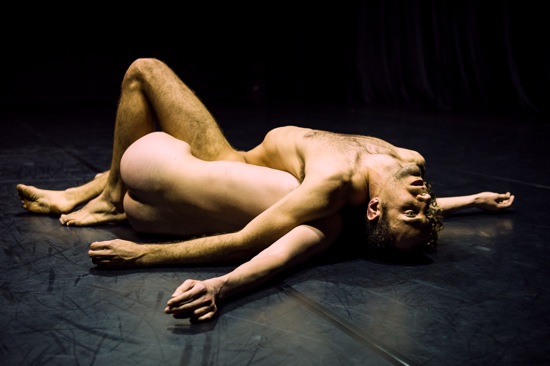
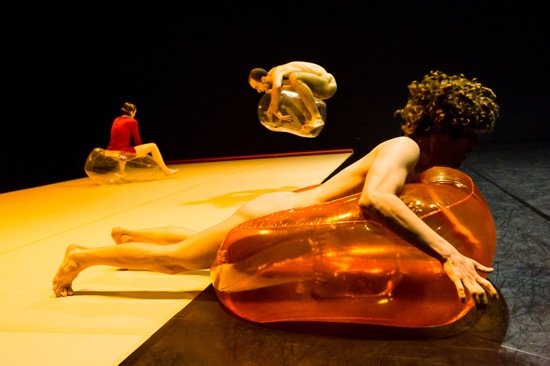
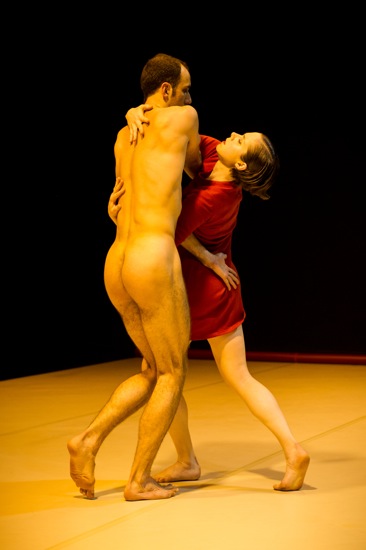
“two men and two women, standing shoulder to shoulder, blank-faced, opened their jackets or flies, took out their genitals or breasts, and made them dance in fastidious synchrony.”
I seem to recall a dance critic saying that you can’t really choreograph for a penis…
Yep, that was me (except my exact title was “You Can’t Choreograph a Penis”). You can, I guess, choreograph with it.
its shocking. big triumph. total work in the amazing meaning.freedom of art. what an amazing production.i wish i saw it on stage. the images looks like it was taken from the classic known paintings. had you ever worked with visual art project?